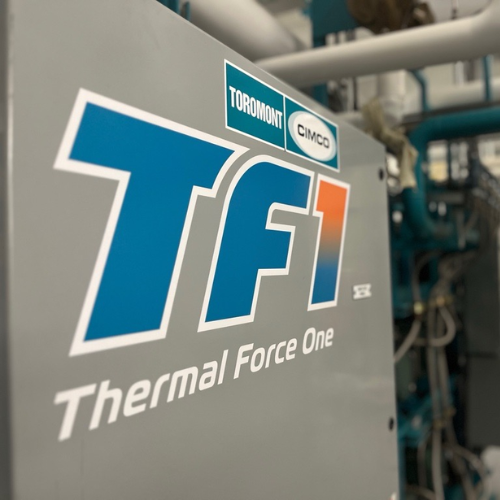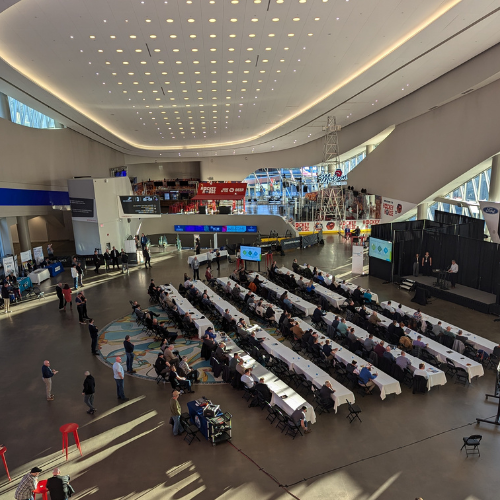North Vancouver’s only outdoor rink features an integrated CO2 thermal system that efficiently repurposes waste heat for the community’s district energy network.
In the coldest months of the year, the system is able to provide energy to the neighboring commercial and residential buildings. In warmer months, the rink converts into a splash park and plaza where families can enjoy a nice afternoon outdoors.
Warming Winters Threaten Outdoor Rinks
Warming temperatures are forcing many outdoor ice rinks to close their doors as it becomes harder to keep the skating surfaces slush-free. North Vancouver, located in a temperate rainforest, has a winter climate that is often above freezing and rainy – making it impossible to run a natural outdoor rink the same way as in some other parts of Canada.
Still, many Canadian communities see outdoor ice skating as an important investment, and demand for outdoor activities is only increasing. The only solution to keeping these outdoor rinks going for the entire season, is adding refrigeration systems to maintain the skating surface in the warmer months. Such large refrigeration systems can be very expensive (both to install and to maintain) – a significant financial commitment for a seasonal facility.
Plus, the warmer it gets, the more energy the refrigeration system needs to maintain the ice. This means the cost of running such a system is expected to keep climbing as the climate increasingly gets warmer. Consequently, fewer communities will be able to afford to operate these systems. Especially smaller municipalities with smaller budgets who are struggling to make this transition from naturally frozen to refrigerated rinks.
But there is another way to offset these costs and make refrigerated outdoor rinks a viable solution for more communities…
67f9e52a-6550-4dae-8e1a-4acb2d8b1197.png?sfvrsn=c02ad822_1)
Shipyards Breaks the Mold
The Shipyards Commons outdoor skate plaza in North Vancouver also faced this challenge as the region’s winter temperatures rarely drop below freezing. Located on the waterfront at The Shipyards, the 12,000 ft2 Skate Plaza is the region's largest covered outdoor skating rink, set against the beautiful backdrop of downtown Vancouver and the North Shore mountains.
To open this facility, keeping operating costs low while maintaining ice quality was key. Additionally, North Vancouver has committed to achieving net zero emissions by 2050, which meant reducing the facility’s emissions was just as important.
To tick all these boxes, CIMCO designed, manufactured, installed, and commissioned an integrated thermal solution that provides heating while cooling the refrigerated ice slab—with a single high-efficiency CO2 system. This is accomplished through the full heat reclaim capabilities that allows North Vancouver to run the system with lower cost inputs as compared to the originally specified fluorinated refrigerant system (using R507).
Free Heating
The Skate Plaza’s CO2 system feeds into the Lonsdale Energy Corporation District Energy System, allowing waste heat from the rink’s refrigeration system to heat surrounding buildings. It provides enough hot water and space heating to heat the equivalent of 43 homes, offsetting the use of natural gas and reducing related direct emissions. This is basically free heating, since the heat would normally just be dispersed in the atmosphere, and it is provided during winter months when the community needs heating most.
The real genius of the system is the ability to move heat from a lower temperature to a higher one, similar to what is done with residential heat pumps (only this happens on a much larger scale). The system is able to move energy from the freezing cold ice slab and pump it up to a temperature of 80 °C/ 175 °F, allowing it to be used for showers, space heating and various other purposes
.png?sfvrsn=322ad822_1)
Boosting Efficiencies
CIMCO fine-tuned the system during commissioning to ensure it is operating at peak performance and recovering the maximum theoretical heat of the system. This is was very important to ensure optimum efficiency and reduce the payback period of the upgrade.
Karyn Magnusson, the city's chief engineer, acknowledged that creating an outdoor skating rink in North Vancouver's temperate climate was challenging. But CIMCO’s unique system managed to solve this challenge. Magnusson said the system is "incredibly efficient" at removing heat from the ice (using a 13 km web of pipes under the ice surface), compared to other kinds of refrigerants and refrigeration systems.
Furthermore, the system integrates with two separate heating systems, allowing 100% of the energy to be recovered into the district system. Some is available at higher temperatures, and the remainder at lower temperatures. By utilizing the heat in various applications, The Shipyards is able to optimize the energy output of the plant. As a result, the Shipyards rink is two-to-three times more efficient than a standard ice rink, resulting in a significant reduction in energy-related indirect emissions.
“There really is no comparison between a natural refrigerant like CO2 and a fluorinated alternative like R507. CO2 has essentially no negative effects on the environment, it operates far more efficiently, and it provides the opportunity to recover usable heat at 80°C. Plus it’s significantly cheaper, costing about $1/pound while some of the synthetic alternatives cost upwards of $25/pound.”
- Rob Martin, CIMCO Branch Manager
Saving Costs
The benefits of the rink’s thermal system go beyond efficiency, although the subsequent lower utility bill and reduced emissions are a huge plus. As the waste heat is sold to the community’s district energy loop, the rink’s electricity costs can partially be offset to further reducing running costs. This makes the solution more viable, also for smaller communities with budget restraints.
There were more savings too. Rather than having separate systems for heating and cooling, the single integrated system allows the facility to save on space and additional equipment. The refrigeration system is small enough to be installed in the parking garage underground and doesn’t take up valuable space near the skating facility.
The thermal plant is also fully automated and thanks to the use of a safe refrigerant like CO2 (Safety Class A1: non-flammable and non-toxic), it can be operated without any on-site staffing. This means drastically reduced maintenance costs. The system can automatically alert the city staff (who are off-site) of any issues, so they can respond as required. A technician checks in for a few hours weekly to ensure that everything is operating as it should be.
Meeting Net Zero Targets
In addition to creating a new space for the community, the project also aligns with North Vancouver’s Community-Wide Climate Action Plan and marks a huge step towards achieving their Climate Action Targets.
CO2 is well-aligned with sustainability goals as it has 0 Ozone Depletion Potential (ODP) and its Global Warming Potential (GWP) is only 1 – compared to R507 refrigerant’s GWP of 3,985.
“There really is no comparison between a natural refrigerant like CO2 and a fluorinated alternative like R507,” explains Rob Martin, CIMCO Branch Manager. “CO2 has essentially no negative effects on the environment, it operates far more efficiently, and it provides the opportunity to recover usable heat at 80°C. Plus it’s significantly cheaper, costing about $1/pound while some of the synthetic alternatives cost upwards of $25/pound.”
Related Posts

Guysborough Municipality Raises the Bar With All-in-One CO2 Heating, Refrigeration & AC

Sold-Out IRMA Innovation Day Showcases Next-Gen Ice Arena Technologies
.png?sfvrsn=ad12d922_1)
The Business Case for Replacing Your Refrigerant System
STAY UP TO DATE
Get the latest industry insights and important updates delivered right to your inbox.
|
|



